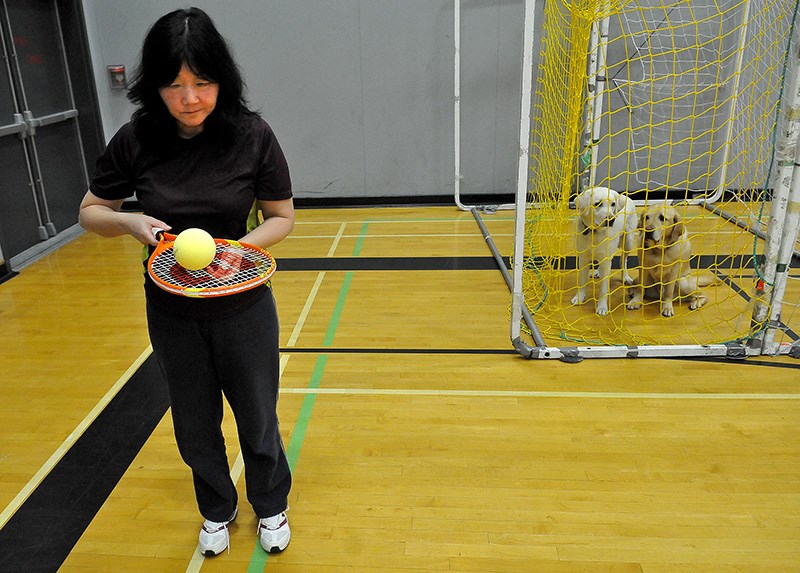Iris Thompson is an active curler, dragon boater and yoga practicioner. And thanks to a new program at Coquitlam’s Pinetree Community Centre (1260 Pinetree Way), she’s renewing her love for tennis.
Thompson can’t see.
Before the Coquitlam woman lost her sight, she loved to get on the court and hit the ball around. Now, she says, “It will be interesting to see what it’s like when I’m blind.”
A new partnership between the BC Blind Sports and Recreation Association and the city of Coquitlam is giving Thompson and other active people aged 14 and up with visual impairments that opportunity with a drop-in tennis program at Pinetree every Monday, from 4:30 to 6 p.m.
Mike Lonergan, the program director for BC Blind Sports, said four players showed up the first week, but the numbers are growing. He said Pinetree’s location at the end of a SkyTrain line is key, as many people with sight impairments rely on transit to get around independently.
Linda Weber and Monica Nelson both caught rides in from Surrey to sate their curiosity about a new sport to add to their roster of activities like curling, dragon boating, snowshoeing, spin and tandem cycling. Both women lost their sight about 12 years ago and they like the idea of a sport they can play independently as most sports for blind athletes rely on a sighted guide to point them in the right direction.
Blind tennis was developed in Japan in 1990 with the invention of a special foam ball which encases a rattling core that makes a distinct sound when it bounces. The court is slightly smaller, and the racquets have shorter handles not unlike those used in racquetball. Totally blind players are allowed to bounce the ball three times, while players with some vision are allowed two bounces every volley.
Lonergan said one of the appeals of blind tennis is that, unlike team sports or group activities, it only takes two people to play a match, and neither needs to be sighted. That makes it ideal for more spontaneous recreation. It’s also a great bonding activity.
“It’s healthy and provides a great peer group,” Lonergan said..
Kiyo Breiting has been coaching blind tennis players for about a year, migrating from working with seniors.
She said her greatest challenge is remembering to verbalize every one of her instructions because, of course, the players can’t see how far apart her feet are when she’s in the ready stance or how the racquet should be oriented when returning a serve.
Breiting starts every session by allowing the players to familiarize themselves with the equipment, rolling the rattling ball around the racquet head to get a spatial sense for its size as well as the sounds the ball makes.
“You have to remember this is about hand and ear coordination, not hand and eye coordination,” Breiting said. She’s also built a special braille-type mock-up of the court on a piece of wood, with shoelaces glued to it for the lines and net that the players can feel with their fingers.
Another quirk of the sport is the need for relatively quiet environs; an outdoor court near a busy highway is not ideal for picking up the sounds of the bouncing, rattling ball.
And then there’s the problem of what to do with guide dogs during a match. On this day, Breiting and Lonergan move a couple of indoor soccer nets together to create an improvised kennel for the three golden labs that have accompanied their people to the gym. After the requisite dog greetings, they stand or sit quietly, peering intently through the netting at all the activity.
Lonergan said it can take 10 or 12 sessions with a new sport for a blind athlete to become familiar and comfortable with it, with the learning curve depending on an athlete’s degree of visual impairment.
But the most important thing is to try it, Lonergan said.
“I encourage all our kids and families to try every sport they can,” he said.
• There is no registration or fee for the drop-in blind tennis program at the Pinetree Community Centre, but sessions are limited to 10 participants. Facilitators from BC Blind Sports will also be on hand to help players navigate their way from the Lafarge Lake-Douglas SkyTrain station and around the community centre if necessary. For more information about Coquitlam’s accessible sports programs, go to www.coquitlam.ca/reaccess. For more information about BC Blind Sports, go to www.bcblindsports.bc.ca.



